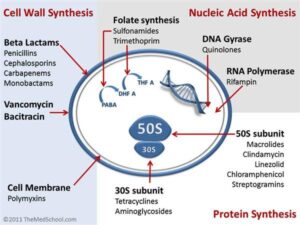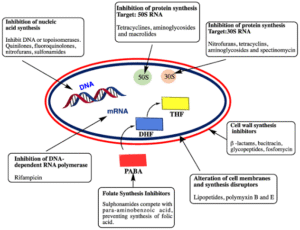Back to: MICROBIOLOGY 100 LEVEL
Welcome to class!
I’m so glad you’re here today. You are doing something wonderful—investing in your education and future. Just know this: I believe in you. Let’s walk through today’s topic together like good friends, and I promise to make it as easy and enjoyable as a gist with your favourite cousin after exams!
Antibiotics: Classes And Modes Of Action
Imagine this: You fall ill with a bad sore throat. You visit a hospital and the doctor gives you medicine, and within a few days—boom! You’re back to yourself. That magic pill that fought off the illness was most likely an antibiotic. Now, let’s break that down in a way that makes complete sense.

Antibiotics are powerful medicines used to treat bacterial infections. Not viral or fungal—just bacterial. This means if you’ve ever had typhoid, staphylococcus or even certain types of pneumonia, antibiotics were likely part of your healing journey.
Now, antibiotics don’t all work the same way. Some kill bacteria outright. Others just stop them from growing so your immune system can finish the job. That’s where classes and modes of action come in.
Classes of Antibiotics
Antibiotics are grouped based on their structure and how they work. Let’s look at the major ones:
1. Penicillins
These were the first antibiotics ever discovered—imagine something as simple as mould on bread leading to a medical breakthrough! Penicillins (like amoxicillin) are used for infections like ear infections, strep throat, and some types of skin infections.
2. Cephalosporins
These are like cousins to penicillins. They’re used when penicillins don’t work well or when someone is allergic. Think of them as your plan B superheroes.
3. Macrolides
These include erythromycin and azithromycin. They’re great when you need something less harsh and can treat respiratory tract infections and skin issues.
4. Tetracyclines
These are often used for acne and other infections. One famous one is doxycycline. But they’re not for children under 8 or pregnant women.
5. Aminoglycosides
These are strong antibiotics used for serious infections. They often come as injections—so not your everyday drug.
6. Quinolones (or fluoroquinolones)
Ciprofloxacin is one you might have heard of. These are used for more serious infections like UTIs or some forms of gastroenteritis.
Modes of Action
Let’s now look at how these antibiotics actually fight the bacteria:
1. Inhibiting cell wall synthesis
Think of the bacterial cell wall as armour. Some antibiotics, like penicillins and cephalosporins, punch holes in that armour, making the bacteria weak and easy to destroy.
2. Inhibiting protein synthesis
Bacteria need proteins to grow and function. Macrolides, tetracyclines and aminoglycosides block their ability to make these proteins—just like locking up their kitchen so they can’t cook food to survive.

3. Inhibiting DNA replication
Quinolones attack the enzymes bacteria need to copy their DNA. No DNA? No baby bacteria. Problem solved.
4. Disrupting cell membrane
Some antibiotics, like polymyxins, damage the bacterial cell membrane so much that the bacteria just can’t hold together.
Summary
So, antibiotics come in different classes—penicillins, cephalosporins, macrolides, tetracyclines, aminoglycosides, and quinolones. They work in different ways: by destroying the bacteria’s wall, stopping them from making proteins, preventing their DNA from copying, or bursting their membranes. Always remember, antibiotics don’t work on viruses, so using them the wrong way can make them less effective!
Evaluation
- Mention three classes of antibiotics and an example of each.
- Explain two ways antibiotics can kill or stop bacteria.
- Why should antibiotics not be used for viral infections?
I’m super proud of you for staying with me through this lesson. You’re on a journey to becoming one of Nigeria’s best microbiologists—and Afrilearn is here to support you all the way. Keep shining, keep believing in yourself, and I can’t wait to see you in our next lesson!
